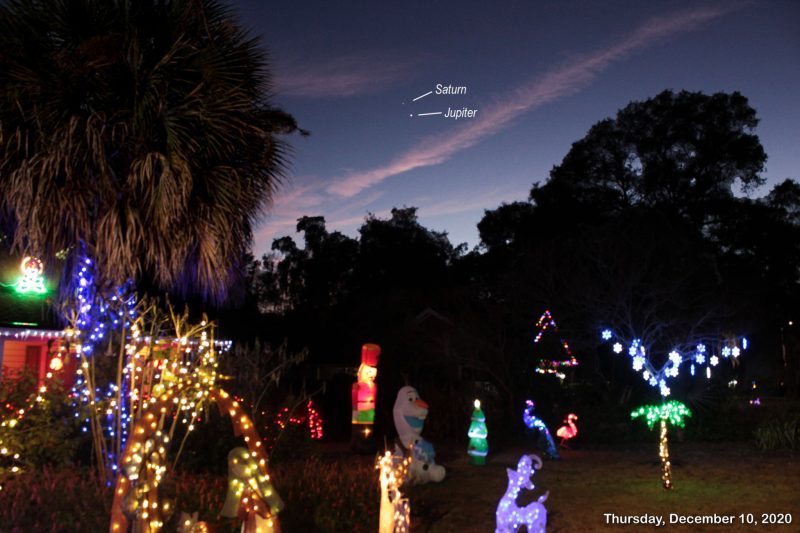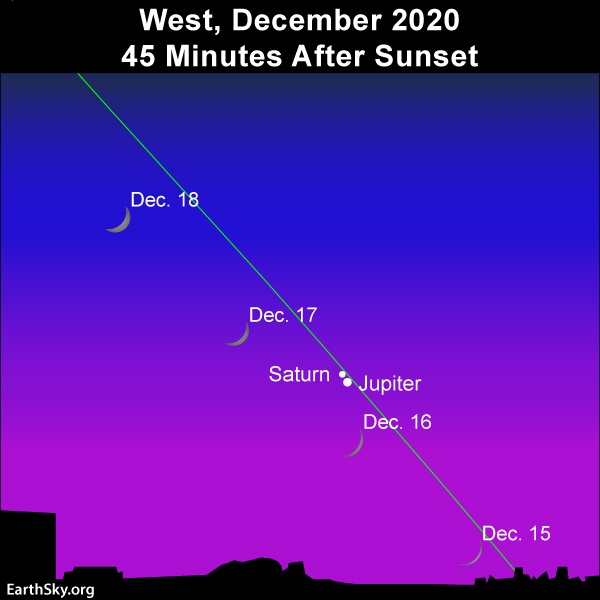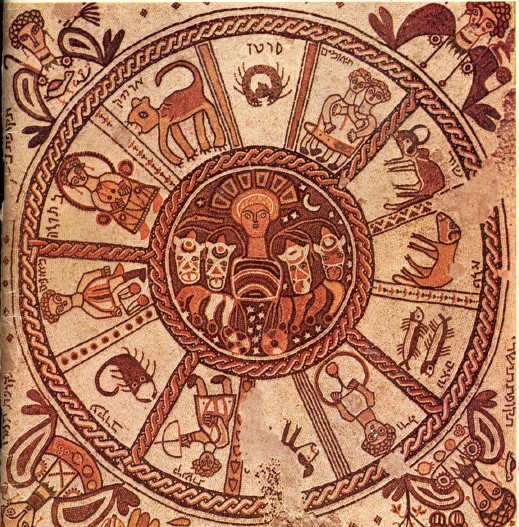

View at EarthSky Community Photos. | Patrick Prokop in Savannah, Georgia caught Jupiter and Saturn close together on December 10, 2020, above a display of holidays lights. Thanks, Patrick! Start watching now, and see the bright couple draw closer to one another between now and December 21! Read more.
EarthSky lunar calendars are cool! They make great gifts. Order now. Going fast!
We’re getting lots of questions in 2020 about a rumor that’s floating around, that the planets Jupiter and Saturn will appear as one star around the time of their great conjunction on December 21. Many are heralding them as a Christmas Star and comparing them to the Star of Bethlehem. It’s true that Jupiter – brightest starlike object in the evening sky now – and Saturn are drawing closer and closer together. On December 21, they’ll be separated by only 0.01 of a degree and visible from around the globe in the western twilight sky. They’ll be very close! But one star? The questions go something like this:
Several people have posted on Facebook an article that Jupiter and Saturn will soon align and create a ‘Christmas star.’ Is this accurate?
The short answer here is that Jupiter and Saturn will certainly look unusual. They’ll look to many like a double planet. They’ll be spectacular to see! But one star? There’s a lot of variation to how people see things in the sky, especially when they are near the horizon, which Jupiter and Saturn will be when they’re closest. So, for example, those with poor eyesight might indeed see them as a single star. Atmospheric conditions in your area will also play a role; a lot of murk near the horizon will distort your view.
The truth is that no one alive today knows for certain what Jupiter and Saturn will look like on December 21, in part because this particular event hasn’t happened in our lifetimes (!). But – generally speaking – the experts we asked said, no, Jupiter and Saturn will likely not appear as a single object to the eye around the time of their December 21, 2020 conjunction. Here’s what a few sky-watching experts said:
EarthSky’s lead sky writer Bruce McClure said:
I do not know for certain, but doubt it. I’m guessing people with decent vision will view Jupiter and Saturn as two distinct points of light. Part of the fun is to wait and see. Remember that people with good vision can see Venus as a crescent with the eye alone when its angular diameter is one minute of arc or larger. At their closest, the angular separation between Jupiter and Saturn will be 6 times that distance: 6 minutes of arc.
Jay Ryan of Classical Astronomy told EarthSky he also disagrees with the “one star” idea. He pointed out in his newsletter for December that a commonly seen psychological phenomenon – the moon illusion – makes sky objects look bigger when seen near the horizon. And the moon illusion also works for stars or planets near one another in the sky. It’ll surely affect Jupiter and Saturn. Jay said:
As this pair gets close to the horizon, the moon illusion makes them appear farther apart, even though they are physically closer … Just as the sun and moon appear larger when near the horizon, the distance between Jupiter and Saturn also appear larger when they are close to setting.
Jupiter and Saturn will indeed be close to setting when you see them on December 21. You’ll need to watch for them in the western part of the sky, shortly after sunset. They’ll appear exceedingly striking – exceedingly close together – maybe as an “elongated” star to you, especially if you have poor eyesight or poor atmospheric conditions.
Read more about Jupiter and Saturn’s December 21 great conjunction
View photos: Favorite photos of Jupiter and Saturn drawing near!

You can see Jupiter and Saturn any evening in December 2020, but they’ll be especially striking around December 16 and 17, when the young moon will sweep past them. Read more.
So what was the Star of Bethlehem, or Christmas star? It’s a major seasonal symbol throughout the world. The story suggests the silhouettes of three regally attired men on camels, gazing across gently rolling hills or dunes of white, to a tiny solitary building in the distance. The night is dark, and one exceedingly bright star appears to hover over the small building, sending a bright shaft of light earthward to illuminate its outline. Another light glows gently inside.
That is the picture most of us have of the Christmas Star, but it’s an image derived more from imagination and greeting cards than from the Bible. In fact, the Gospel of Matthew in the New Testament is the only place this “star” is mentioned in the Bible (Matt 2:2, 7-10, King James Version). Even there, information on the star is sparse. The most telling reference is Matt. 2:9:
When they had heard the king, they departed; and, lo, the star, which they saw in the east, went before them, till it came and stood over where the young child was.
For anyone inclined to insist on the literal truth of scripture, this verse solves the question. If this verse is literally true, then the Star of Bethlehem could not have been any known natural phenomenon, simply because none would move that way.

Basilica of Sant’Apollinare Nuovo in Ravenna, Italy: The Three Wise Men (named Balthasar, Melchior, and Gaspar). Detail from 6th-century Mary and Child surrounded by angels mosaic, by the so-called “Master of Sant’Apollinare”. Image via Wikipedia.
However, if we grant the author of Matthew – who assuredly was not an eyewitness at the Nativity – a little artistic license, the “star” might not have appeared literally in the way described. In that case we can consider some natural, astronomical possibilities. In fact, there is some uncertainty about the use of the word for star in the Greek manuscript. Some contend that the word could have meant or implied an object other than a physical star. There’s even some possibility that Jupiter was involved in the original “Christmas star” story.
Some believe the Christmas star was really a conjunction – or close meeting – of Jupiter with two other planets, Saturn and Mars. Planets were “wandering stars” to the ancients, and to many they bore great astrological or mystical significance. Astronomers know that there was a series of such conjunctions in 6 and 5 B.C., occurring in the constellation Pisces (the Fishes), said by some to be the astrological “sign of the Jews.” To add more credence for later Christian writers such as Matthew, the sign of a fish later became the secret sign for Christians.
But there are other astronomical possibilities for the Christmas star. Some artistic depictions show what appear to be a bright meteor or “falling star.” Although exploding meteors, sometimes called bolides or fireballs, can be startling and truly impressive, they last only seconds. They can occur at any time. People far more aware of the night sky than the modern city dweller is likely would not have placed much significance in them. It seems unlikely such transient phenomena could have “led” the wise men to Bethlehem.
And there are other problems. For example, we don’t know for sure when Jesus was born. Due to an error by a Church cleric hundreds of years later, the birth of Jesus was thought to be at least four years later than it really was. So today we know that the birth was no later than 4 B.C., and it could have been a little earlier. And it certainly was not on December 25. The Bible does not say, leaving us few clues. One clue we do have, however, is the reference that shepherds were out in the field “keeping watch over their flock by night” (Luke 2:8), something the scholars say was likely only done in the spring when lambs were born. Thus the birth was likely in the spring, probably between 7 and 4 B.C.
Few astronomical records were kept at the time, except by the Chinese and Koreans. They did record what might have been comets in 5 and possibly again in 4 B.C. The main problem here is that comets were generally regarded as omens of evil and bad fortune by the Chinese and likely also by the magi-astrologers the New Testament calls “wise men.” Rather than follow such a cometary “star,” they likely would have gone the other way.
Another possibility is that the Christmas Star was a nova or supernova, a previously unseen star that suddenly brightens in a big way. Indeed, one such star was recorded by the Chinese in the spring of 5 B.C, and was seen for more than two months. However, its position in the constellation Capricornus meant that it likely would not have seemed to “lead” the wise men in the manner implied in the Bible.
Unless some major and indisputable archaeological discovery is found to settle the question once and for all, the mystery of what the Christmas Star was will remain in the realm of faith. Science cannot explain it as any known physical object; history offers no clear record; and religion offers only an untestable miraculous apparition. But although there may be no agreement on the nature of the star or even its actual sighting two millenia ago, all sides can agree on the message the Christmas star heralded: “… on earth peace, good will toward men.” (Luke 2:14).

Mosaic pavement of a 6th century synagogue at Beth Alpha, Jezreel Valley, northern Israel. It was discovered in 1928. Signs of the zodiac surround the central chariot of the sun (a Greek motif), while the corners depict the 4 “turning points” (“tekufot”) of the year, solstices and equinoxes, each named for the month in which it occurs- tequfah of Tishrei, tequfah of Tevet, tequfah of Ni(san), tequfah of Tamuz. Image via Wikipedia.

The bright star Regulus and the Leo I dwarf galaxy. Image via Russell Croman.
Bottom line: Will Jupiter and Saturn come together to appear as a single star – a “Christmas star” or Star of Bethlehem – at their great conjunction on December 21, 2020? Some thoughts and some possible astronomical explanations for the Christmas star.
from EarthSky https://ift.tt/2T3SaWb


View at EarthSky Community Photos. | Patrick Prokop in Savannah, Georgia caught Jupiter and Saturn close together on December 10, 2020, above a display of holidays lights. Thanks, Patrick! Start watching now, and see the bright couple draw closer to one another between now and December 21! Read more.
EarthSky lunar calendars are cool! They make great gifts. Order now. Going fast!
We’re getting lots of questions in 2020 about a rumor that’s floating around, that the planets Jupiter and Saturn will appear as one star around the time of their great conjunction on December 21. Many are heralding them as a Christmas Star and comparing them to the Star of Bethlehem. It’s true that Jupiter – brightest starlike object in the evening sky now – and Saturn are drawing closer and closer together. On December 21, they’ll be separated by only 0.01 of a degree and visible from around the globe in the western twilight sky. They’ll be very close! But one star? The questions go something like this:
Several people have posted on Facebook an article that Jupiter and Saturn will soon align and create a ‘Christmas star.’ Is this accurate?
The short answer here is that Jupiter and Saturn will certainly look unusual. They’ll look to many like a double planet. They’ll be spectacular to see! But one star? There’s a lot of variation to how people see things in the sky, especially when they are near the horizon, which Jupiter and Saturn will be when they’re closest. So, for example, those with poor eyesight might indeed see them as a single star. Atmospheric conditions in your area will also play a role; a lot of murk near the horizon will distort your view.
The truth is that no one alive today knows for certain what Jupiter and Saturn will look like on December 21, in part because this particular event hasn’t happened in our lifetimes (!). But – generally speaking – the experts we asked said, no, Jupiter and Saturn will likely not appear as a single object to the eye around the time of their December 21, 2020 conjunction. Here’s what a few sky-watching experts said:
EarthSky’s lead sky writer Bruce McClure said:
I do not know for certain, but doubt it. I’m guessing people with decent vision will view Jupiter and Saturn as two distinct points of light. Part of the fun is to wait and see. Remember that people with good vision can see Venus as a crescent with the eye alone when its angular diameter is one minute of arc or larger. At their closest, the angular separation between Jupiter and Saturn will be 6 times that distance: 6 minutes of arc.
Jay Ryan of Classical Astronomy told EarthSky he also disagrees with the “one star” idea. He pointed out in his newsletter for December that a commonly seen psychological phenomenon – the moon illusion – makes sky objects look bigger when seen near the horizon. And the moon illusion also works for stars or planets near one another in the sky. It’ll surely affect Jupiter and Saturn. Jay said:
As this pair gets close to the horizon, the moon illusion makes them appear farther apart, even though they are physically closer … Just as the sun and moon appear larger when near the horizon, the distance between Jupiter and Saturn also appear larger when they are close to setting.
Jupiter and Saturn will indeed be close to setting when you see them on December 21. You’ll need to watch for them in the western part of the sky, shortly after sunset. They’ll appear exceedingly striking – exceedingly close together – maybe as an “elongated” star to you, especially if you have poor eyesight or poor atmospheric conditions.
Read more about Jupiter and Saturn’s December 21 great conjunction
View photos: Favorite photos of Jupiter and Saturn drawing near!

You can see Jupiter and Saturn any evening in December 2020, but they’ll be especially striking around December 16 and 17, when the young moon will sweep past them. Read more.
So what was the Star of Bethlehem, or Christmas star? It’s a major seasonal symbol throughout the world. The story suggests the silhouettes of three regally attired men on camels, gazing across gently rolling hills or dunes of white, to a tiny solitary building in the distance. The night is dark, and one exceedingly bright star appears to hover over the small building, sending a bright shaft of light earthward to illuminate its outline. Another light glows gently inside.
That is the picture most of us have of the Christmas Star, but it’s an image derived more from imagination and greeting cards than from the Bible. In fact, the Gospel of Matthew in the New Testament is the only place this “star” is mentioned in the Bible (Matt 2:2, 7-10, King James Version). Even there, information on the star is sparse. The most telling reference is Matt. 2:9:
When they had heard the king, they departed; and, lo, the star, which they saw in the east, went before them, till it came and stood over where the young child was.
For anyone inclined to insist on the literal truth of scripture, this verse solves the question. If this verse is literally true, then the Star of Bethlehem could not have been any known natural phenomenon, simply because none would move that way.

Basilica of Sant’Apollinare Nuovo in Ravenna, Italy: The Three Wise Men (named Balthasar, Melchior, and Gaspar). Detail from 6th-century Mary and Child surrounded by angels mosaic, by the so-called “Master of Sant’Apollinare”. Image via Wikipedia.
However, if we grant the author of Matthew – who assuredly was not an eyewitness at the Nativity – a little artistic license, the “star” might not have appeared literally in the way described. In that case we can consider some natural, astronomical possibilities. In fact, there is some uncertainty about the use of the word for star in the Greek manuscript. Some contend that the word could have meant or implied an object other than a physical star. There’s even some possibility that Jupiter was involved in the original “Christmas star” story.
Some believe the Christmas star was really a conjunction – or close meeting – of Jupiter with two other planets, Saturn and Mars. Planets were “wandering stars” to the ancients, and to many they bore great astrological or mystical significance. Astronomers know that there was a series of such conjunctions in 6 and 5 B.C., occurring in the constellation Pisces (the Fishes), said by some to be the astrological “sign of the Jews.” To add more credence for later Christian writers such as Matthew, the sign of a fish later became the secret sign for Christians.
But there are other astronomical possibilities for the Christmas star. Some artistic depictions show what appear to be a bright meteor or “falling star.” Although exploding meteors, sometimes called bolides or fireballs, can be startling and truly impressive, they last only seconds. They can occur at any time. People far more aware of the night sky than the modern city dweller is likely would not have placed much significance in them. It seems unlikely such transient phenomena could have “led” the wise men to Bethlehem.
And there are other problems. For example, we don’t know for sure when Jesus was born. Due to an error by a Church cleric hundreds of years later, the birth of Jesus was thought to be at least four years later than it really was. So today we know that the birth was no later than 4 B.C., and it could have been a little earlier. And it certainly was not on December 25. The Bible does not say, leaving us few clues. One clue we do have, however, is the reference that shepherds were out in the field “keeping watch over their flock by night” (Luke 2:8), something the scholars say was likely only done in the spring when lambs were born. Thus the birth was likely in the spring, probably between 7 and 4 B.C.
Few astronomical records were kept at the time, except by the Chinese and Koreans. They did record what might have been comets in 5 and possibly again in 4 B.C. The main problem here is that comets were generally regarded as omens of evil and bad fortune by the Chinese and likely also by the magi-astrologers the New Testament calls “wise men.” Rather than follow such a cometary “star,” they likely would have gone the other way.
Another possibility is that the Christmas Star was a nova or supernova, a previously unseen star that suddenly brightens in a big way. Indeed, one such star was recorded by the Chinese in the spring of 5 B.C, and was seen for more than two months. However, its position in the constellation Capricornus meant that it likely would not have seemed to “lead” the wise men in the manner implied in the Bible.
Unless some major and indisputable archaeological discovery is found to settle the question once and for all, the mystery of what the Christmas Star was will remain in the realm of faith. Science cannot explain it as any known physical object; history offers no clear record; and religion offers only an untestable miraculous apparition. But although there may be no agreement on the nature of the star or even its actual sighting two millenia ago, all sides can agree on the message the Christmas star heralded: “… on earth peace, good will toward men.” (Luke 2:14).

Mosaic pavement of a 6th century synagogue at Beth Alpha, Jezreel Valley, northern Israel. It was discovered in 1928. Signs of the zodiac surround the central chariot of the sun (a Greek motif), while the corners depict the 4 “turning points” (“tekufot”) of the year, solstices and equinoxes, each named for the month in which it occurs- tequfah of Tishrei, tequfah of Tevet, tequfah of Ni(san), tequfah of Tamuz. Image via Wikipedia.

The bright star Regulus and the Leo I dwarf galaxy. Image via Russell Croman.
Bottom line: Will Jupiter and Saturn come together to appear as a single star – a “Christmas star” or Star of Bethlehem – at their great conjunction on December 21, 2020? Some thoughts and some possible astronomical explanations for the Christmas star.
from EarthSky https://ift.tt/2T3SaWb

Aucun commentaire:
Enregistrer un commentaire